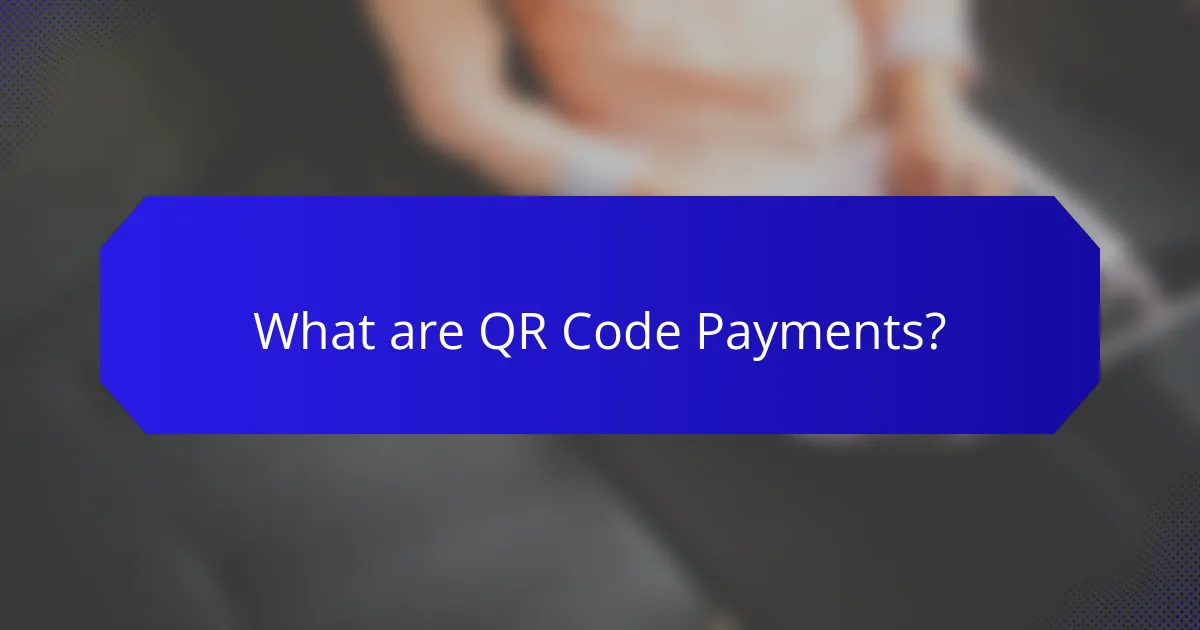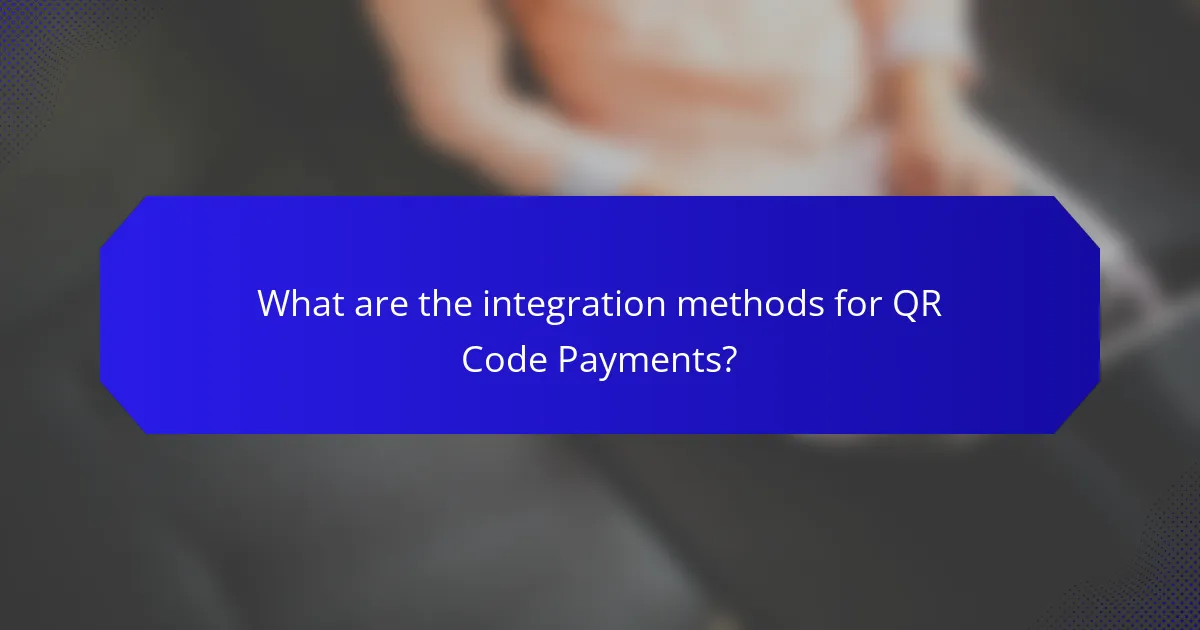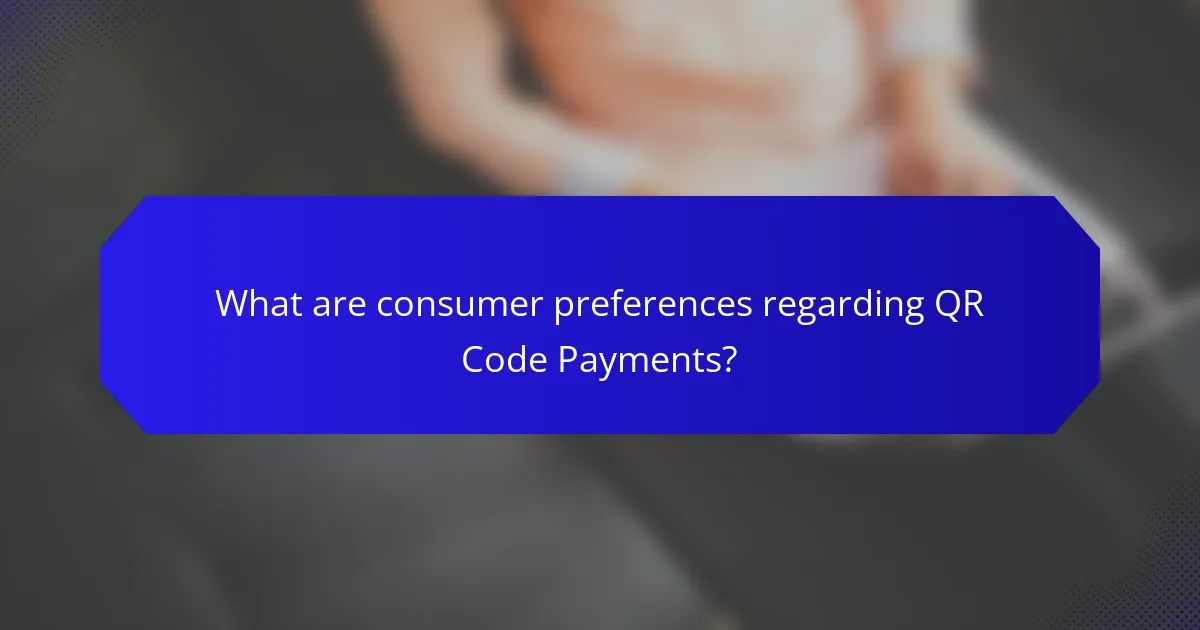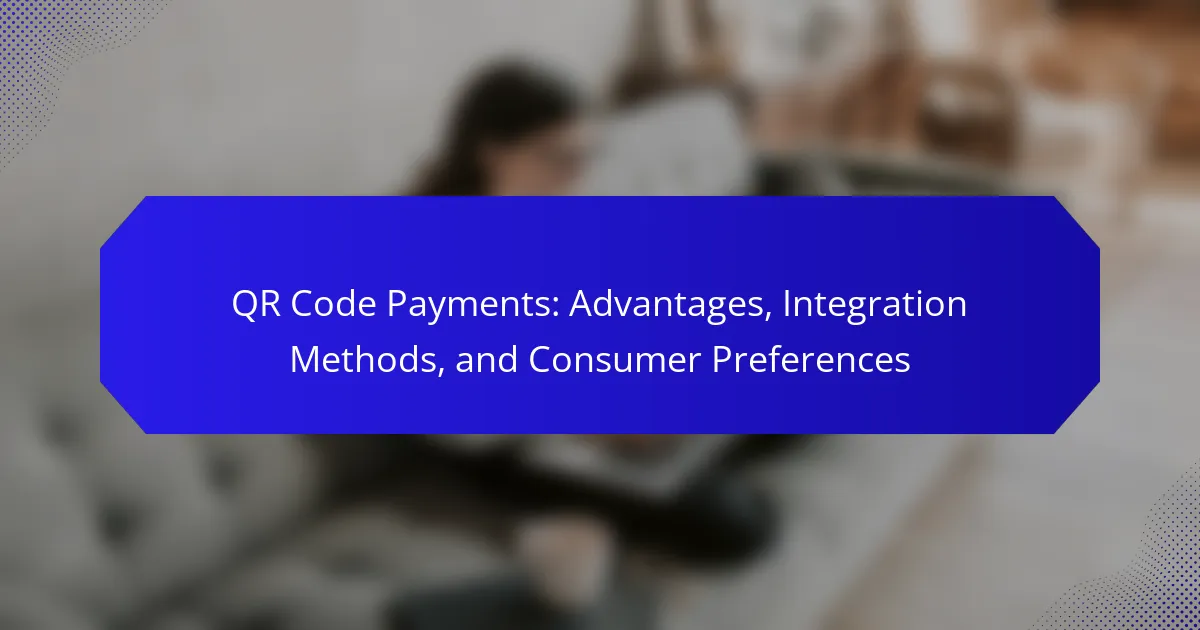QR Code Payments utilize Quick Response (QR) codes to facilitate secure and efficient transactions via mobile devices. This payment method allows consumers to scan a merchant’s QR code, initiating a payment request through digital wallets or banking apps. The article explores the growing adoption of QR Code Payments, projected to exceed $4.5 trillion by 2025, and highlights various integration methods such as API, SDK, and web-based solutions that enhance transaction efficiency. Additionally, it examines consumer preferences, emphasizing the importance of convenience, speed, and security, with a significant percentage of users favoring QR Code payments for contactless transactions.

What are QR Code Payments?
QR Code Payments are a method of transaction that utilizes Quick Response (QR) codes for processing payments. These codes can be scanned by mobile devices to facilitate the transfer of funds. QR Code Payments enable consumers to pay for goods and services quickly and securely. The process typically involves a customer scanning a merchant’s QR code with their smartphone. This action initiates a payment request through a digital wallet or banking app. The transaction is completed once the customer confirms the payment on their device. According to a report by Juniper Research, the value of mobile payments, including QR Code Payments, is expected to exceed $4.5 trillion by 2025. This growth underscores the increasing adoption of QR Code Payments in various markets.
How do QR Code Payments function?
QR code payments function by allowing users to scan a QR code to initiate a transaction. The QR code contains payment information, such as the merchant’s account details. Users typically use a mobile payment app to scan the code. Once scanned, the app retrieves the payment information from the code. Users then confirm the transaction amount and authorize the payment. This process often occurs in real-time, ensuring quick transactions. According to a study by Statista, QR code payments have seen significant growth, with an increase of 30% in usage from 2020 to 2021. This method enhances convenience and security in digital payments.
What technology underpins QR Code Payments?
QR Code Payments are underpinned by two main technologies: QR code generation and mobile payment processing. QR codes are two-dimensional barcodes that store data such as payment information. This data is scanned by a smartphone camera or a dedicated scanner. Mobile payment processing technology facilitates the transaction between the consumer’s bank and the merchant’s bank. This process often utilizes secure protocols like HTTPS for data transmission. Additionally, technologies such as NFC (Near Field Communication) may complement QR code payments for enhanced security. The integration of these technologies allows for seamless, contactless transactions. According to a report by Statista, the global mobile payment market is projected to reach over $12 trillion by 2025, demonstrating the growing reliance on this technology.
How is a QR Code generated for payments?
A QR Code for payments is generated using specific software or applications designed for this purpose. The process begins with the input of payment details, such as the amount and merchant information. The software encodes this information into a QR Code format. This encoded data is then transformed into a visual representation, which can be scanned by users. Many payment platforms, like PayPal or Square, offer built-in QR Code generation tools. These tools ensure that the generated QR Code is unique and secure for each transaction. Users can then display the QR Code for customers to scan and complete the payment. This method streamlines the payment process and enhances user convenience.
What advantages do QR Code Payments offer?
QR Code payments offer several advantages, including convenience, speed, and security. Users can complete transactions quickly by scanning a code with their mobile device. This method eliminates the need for physical cash or cards, streamlining the payment process. Additionally, QR Code payments reduce the risk of fraud associated with card skimming. According to a study by Juniper Research, mobile payment transactions are expected to reach $6.7 trillion by 2024, highlighting the growing adoption of this technology. Furthermore, QR Codes can be easily generated and customized for different businesses, enhancing branding opportunities. They also facilitate contactless payments, which have become essential in health-conscious environments.
How do QR Code Payments enhance transaction speed?
QR Code payments enhance transaction speed by allowing instant scanning and processing of payments. Users simply scan a QR code with their mobile device to initiate payment. This eliminates the need for manual entry of card details or cash handling. Transactions typically complete in seconds, significantly reducing wait times. A study by Juniper Research found that QR code payments can be processed up to 40% faster than traditional methods. The streamlined process minimizes human error and speeds up the overall checkout experience.
What cost savings can businesses expect with QR Code Payments?
Businesses can expect significant cost savings with QR Code Payments. Transaction fees are typically lower compared to traditional credit card processing. Many QR code payment systems charge flat fees instead of percentage-based fees. This can lead to savings, especially for small transactions. Additionally, QR Code Payments reduce the need for physical infrastructure like card readers. Businesses also save on maintenance and operational costs associated with these devices. Studies indicate that companies adopting QR payments have reduced transaction costs by up to 30%. These savings can enhance overall profitability and improve cash flow management for businesses.
How do QR Code Payments improve customer experience?
QR Code payments improve customer experience by offering a fast and convenient transaction method. Customers can complete payments with a simple scan, reducing wait times at checkout. This method eliminates the need for cash or physical cards, enhancing security and ease of use. QR Code payments are accessible for smartphones, which many customers already possess. Additionally, they facilitate contactless transactions, aligning with hygiene preferences, especially post-pandemic. According to a report by Statista, 74% of consumers prefer contactless payments for their speed and safety. This preference indicates a significant shift towards digital payment solutions, enhancing overall satisfaction.

What are the integration methods for QR Code Payments?
The integration methods for QR Code payments include API integration, SDK integration, and web-based solutions. API integration allows businesses to connect their payment systems directly to payment processors, enabling seamless transactions. SDK integration provides software development kits that facilitate the incorporation of QR payment functionality into mobile applications. Web-based solutions involve embedding QR code payment options on websites, allowing users to make payments directly through their browsers. These methods enhance transaction efficiency and user experience. According to a report by Statista, the global mobile payment market is projected to reach over $4 trillion by 2024, highlighting the growing adoption of QR Code payments.
How can businesses integrate QR Code Payments into their systems?
Businesses can integrate QR Code Payments by selecting a payment processor that supports QR codes. This processor will provide the necessary software and tools for implementation. Next, businesses should generate unique QR codes for each transaction or product. These codes can be displayed on screens or printed for customer access.
After that, businesses need to ensure their point-of-sale systems can scan and process these QR codes. This may involve updating existing hardware or software. Additionally, training staff on how to handle QR code transactions is essential.
Finally, businesses should promote the use of QR code payments to customers, highlighting their convenience and security. According to a 2022 survey, 70% of consumers prefer contactless payment options, indicating a growing trend towards QR code usage.
What software solutions support QR Code Payment integration?
Software solutions that support QR Code Payment integration include Stripe, PayPal, and Square. These platforms offer APIs and SDKs for easy integration. Stripe allows businesses to generate and scan QR codes for payment processing. PayPal provides a QR code feature within its app for seamless transactions. Square offers a point-of-sale system that includes QR code payment options. Each of these solutions is widely adopted and trusted in the industry. They enable fast and secure transactions, enhancing customer experience.
How do mobile apps facilitate QR Code Payments?
Mobile apps facilitate QR Code payments by enabling users to scan QR codes for transactions. The app generates a unique QR code linked to the user’s payment information. Users can scan this code at the point of sale using their mobile device’s camera. The app then processes the payment securely through a payment gateway. This method allows for quick and contactless transactions. According to a report by Statista, QR code payments are expected to reach $2.7 trillion globally by 2025. This growth is driven by the convenience and security offered by mobile apps.
What are the best practices for implementing QR Code Payments?
To implement QR Code Payments effectively, businesses should ensure that their QR codes are easily scannable. This involves using high-contrast colors and avoiding complex designs. Additionally, businesses must provide clear instructions for customers on how to use the QR code for payments. Regular testing of the QR codes is essential to ensure they function correctly across various devices.
Security measures should be a priority. Implementing encryption and secure payment gateways can protect sensitive customer information. It’s also important to educate customers about the security of QR code payments to build trust.
Tracking and analytics tools should be integrated to monitor the performance of QR code transactions. This data can help optimize the payment process. Offering multiple payment options within the QR code can enhance customer convenience.
Finally, promoting the use of QR code payments through marketing campaigns can increase adoption rates. According to a survey by Statista, 29% of consumers reported using QR codes for payments in 2021, indicating growing acceptance.
How should businesses design their QR Codes for optimal scanning?
Businesses should design their QR Codes with high contrast colors for optimal scanning. High contrast ensures that the code is easily distinguishable from its background. Using a simple design without excessive elements enhances readability. It is crucial to maintain a minimum size of 1 inch by 1 inch for effective scanning. Additionally, incorporating a clear call-to-action can guide users on how to interact with the code. Testing the QR Code with multiple devices ensures compatibility across platforms. According to a study by the QR Code Tracking, codes that follow these guidelines have a 30% higher scan rate.
What security measures should be taken with QR Code Payments?
Implementing security measures for QR code payments is essential to protect users and transactions. Users should always verify the source of the QR code before scanning. This helps prevent phishing attacks. Additionally, using secure payment apps with encryption adds a layer of protection. Regularly updating the payment app ensures it has the latest security features.
Consumers should avoid using public Wi-Fi when making payments. Public networks can expose sensitive information. Enabling two-factor authentication provides an extra security layer. This requires a second form of verification during transactions.
Monitoring account activity for unauthorized transactions is crucial. This allows for quick action if fraud occurs. Educating users about potential scams enhances overall security. Awareness of common threats can prevent falling victim to fraud.

What are consumer preferences regarding QR Code Payments?
Consumer preferences regarding QR Code payments are primarily influenced by convenience, speed, and security. Many consumers favor QR Code payments for their ease of use. A survey by Statista in 2022 reported that 60% of consumers preferred QR Code payments for contactless transactions. Additionally, 55% of respondents indicated that they appreciated the quick transaction process associated with QR Codes. Security is also a significant factor; 70% of users feel that QR Code payments are safer than traditional cash transactions. Overall, convenience, speed, and security drive consumer preferences for QR Code payments.
Why do consumers prefer QR Code Payments over traditional methods?
Consumers prefer QR Code Payments over traditional methods due to their speed and convenience. QR Code Payments allow for instant transactions by scanning a code with a smartphone. This eliminates the need for cash or card swiping, which can be time-consuming. Additionally, QR Codes enhance security by minimizing physical contact and reducing card fraud risks. According to a study by Juniper Research, mobile payment transactions, including QR Code Payments, are expected to reach $6 trillion by 2024. This growth indicates a significant consumer shift towards digital payment methods. The ease of use and integration with mobile wallets further contribute to consumer preference.
What demographics are most likely to use QR Code Payments?
Younger demographics, particularly millennials and Gen Z, are most likely to use QR code payments. Research indicates that 70% of millennials have used QR codes for transactions. This age group is more tech-savvy and comfortable with mobile payment methods. Additionally, urban dwellers tend to adopt QR code payments more frequently than those in rural areas. A study by Statista shows that 45% of urban consumers prefer contactless payment options, including QR codes. Furthermore, individuals with higher income levels are more inclined to utilize QR code payments. This demographic often seeks convenience and efficiency in financial transactions.
How does consumer familiarity with technology influence QR Code Payment usage?
Consumer familiarity with technology significantly enhances QR Code Payment usage. Individuals who are comfortable with smartphones and apps are more likely to adopt QR Code Payments. Research shows that technology-savvy consumers perceive QR Codes as convenient and efficient for transactions. A study by Statista indicates that 79% of smartphone users are aware of QR Codes, leading to increased usage in payment scenarios. Furthermore, familiarity reduces perceived risks associated with new payment methods. Consumers familiar with digital wallets and contactless payments tend to trust QR Code Payments more. This trust directly correlates with higher adoption rates and frequent use. Thus, consumer familiarity with technology is a critical factor in the widespread acceptance of QR Code Payments.
What factors influence consumer adoption of QR Code Payments?
Consumer adoption of QR Code payments is influenced by several key factors. Convenience is a primary factor, as QR codes enable quick transactions without the need for physical cash or cards. Security also plays a significant role; consumers prefer payment methods that protect their financial information. User experience is another factor; an intuitive interface encourages more users to adopt QR Code payments.
Additionally, the availability of QR Code payment options at retailers influences consumer behavior. Familiarity with technology impacts adoption; consumers comfortable with smartphones are more likely to use QR codes. Trust in the payment provider is crucial; established brands tend to see higher adoption rates. Lastly, incentives such as discounts or rewards can motivate consumers to try QR Code payments.
Research indicates that 67% of consumers are more likely to use QR payments if they perceive them as secure (Source: Statista, 2022).
How do marketing strategies affect consumer perceptions of QR Code Payments?
Marketing strategies significantly influence consumer perceptions of QR code payments. Effective marketing can enhance awareness and highlight the convenience of QR code transactions. For instance, campaigns that emphasize security features can alleviate consumer concerns about safety. Studies show that 70% of consumers are more likely to use QR codes when they perceive them as secure. Additionally, promotions and incentives linked to QR code usage can drive consumer engagement. Research indicates that offering discounts for QR payments increases adoption rates by up to 30%. Overall, well-crafted marketing strategies shape positive consumer attitudes towards QR code payments, fostering acceptance and usage.
What role does convenience play in consumer preferences for QR Code Payments?
Convenience significantly influences consumer preferences for QR Code Payments. QR Code Payments allow for quick transactions without the need for cash or cards. This speed enhances the overall shopping experience. According to a study by Juniper Research, 27% of consumers prefer mobile payments due to their convenience. Users can complete payments using their smartphones in seconds. This eliminates the hassle of carrying physical wallets or searching for change. Additionally, QR Codes can be scanned easily in various settings, including retail and dining. The seamless integration of QR Code Payments into mobile apps further increases their appeal.
What tips can businesses follow to enhance consumer acceptance of QR Code Payments?
Businesses can enhance consumer acceptance of QR Code Payments by ensuring user-friendly interfaces. Clear instructions on how to use QR codes can improve understanding. Providing incentives like discounts for using QR payments can motivate customers to adopt the method. Displaying QR codes prominently at checkout locations increases visibility and encourages usage. Regularly promoting the security features of QR payments builds consumer trust. Offering multiple payment options alongside QR codes caters to diverse preferences. Training staff to assist customers with QR payments can enhance the overall experience. Research indicates that 75% of consumers prefer contactless payment options, highlighting the importance of QR codes in modern transactions.
QR Code Payments represent a digital transaction method that utilizes Quick Response codes to facilitate secure and efficient payment processing. This article provides an overview of the functionality, technology, and advantages of QR Code Payments, highlighting their growing adoption in the mobile payment market. Key topics include integration methods for businesses, consumer preferences, and best practices for enhancing user acceptance and security in QR Code transactions. Additionally, the article examines demographic trends influencing QR Code usage and the impact of marketing strategies on consumer perceptions.
